Innovative Approaches to the Use of Artillery in Wildfire Suppression
Abstract
1. Introduction
1.1. Types of Fires
1.2. Non-Standard Firefighting Methods
2. Materials and Methods
2.1. Creating Firebreaks Using Conventional Tube Artillery Ammunition
- Cf—Ammunition consumption (standard) for producing fire (fire strike) with the required density in pieces;
- (Wt and Dt)—Dimensions (area) of the fire strike sector in meters (hectares);
- tf—Required duration of the fire strike in minutes;
- Cha—Ammunition consumption standard per hectare in pieces per minute or per individual target [25].
2.2. Simulation-Based Analysis of the Effectiveness of Artillery Fire-Suppressant Munitions
- Environmental simplification—the model works with a limited number of parameters;
- Data collection—accurate prediction requires reliable data on the chemical properties of suppressants, meteorological conditions, and terrain characteristics;
- Computational complexity—accounting for all variables can be computationally demanding and is not always practical [31].
- Shell Body Material:
- Resistance to high mechanical and thermal loads during firing;
- Capability of controlled fragmentation or mechanical opening upon suppressant release;
- Environmental safety and ability to undergo biodegradation or safe disintegration;
- Low overall weight to ensure effective ballistic performance upon impact.
- 2.
- Trigger Mechanism and Explosive Charge:
- Variable activation mechanism for optimal timing of suppressant release;
- Sufficient explosive force to disperse the suppressant effectively, without destroying it;
- Safe handling during shell loading;
- Controlled dispersion pattern of the fire suppressant.
- 3.
- Type of Fire Suppressant:
- Highly effective suppressant or fire retardant;
- Chemically stable during storage and resistant to overload conditions;
- Good dispersal and adhesion properties.

- Explosive zone (2 m)—The immediate area of the detonation with the highest explosive force and intensity.
- High-concentration zone (10 m) –The zone containing the highest concentration of suppressant, where maximum extinguishing efficiency is expected. This area ensures direct coverage of the target zone, enabling rapid fire knockdown.
- Low-concentration zone (34 m)—A surrounding area where the suppressant is present in lower concentrations. While its direct extinguishing effect is significantly reduced, it may still provide supplementary cooling effects that support fire containment.
- Danger zone (159 m)—The outermost zone, where the suppressant, or the effects of the explosion, may pose potential risks to personnel, equipment, or the surrounding environment. This could be due to chemical toxicity, mechanical shock, or secondary projectiles. It is recommended that the evacuation area extends to a radius of 159 m for safety reasons.
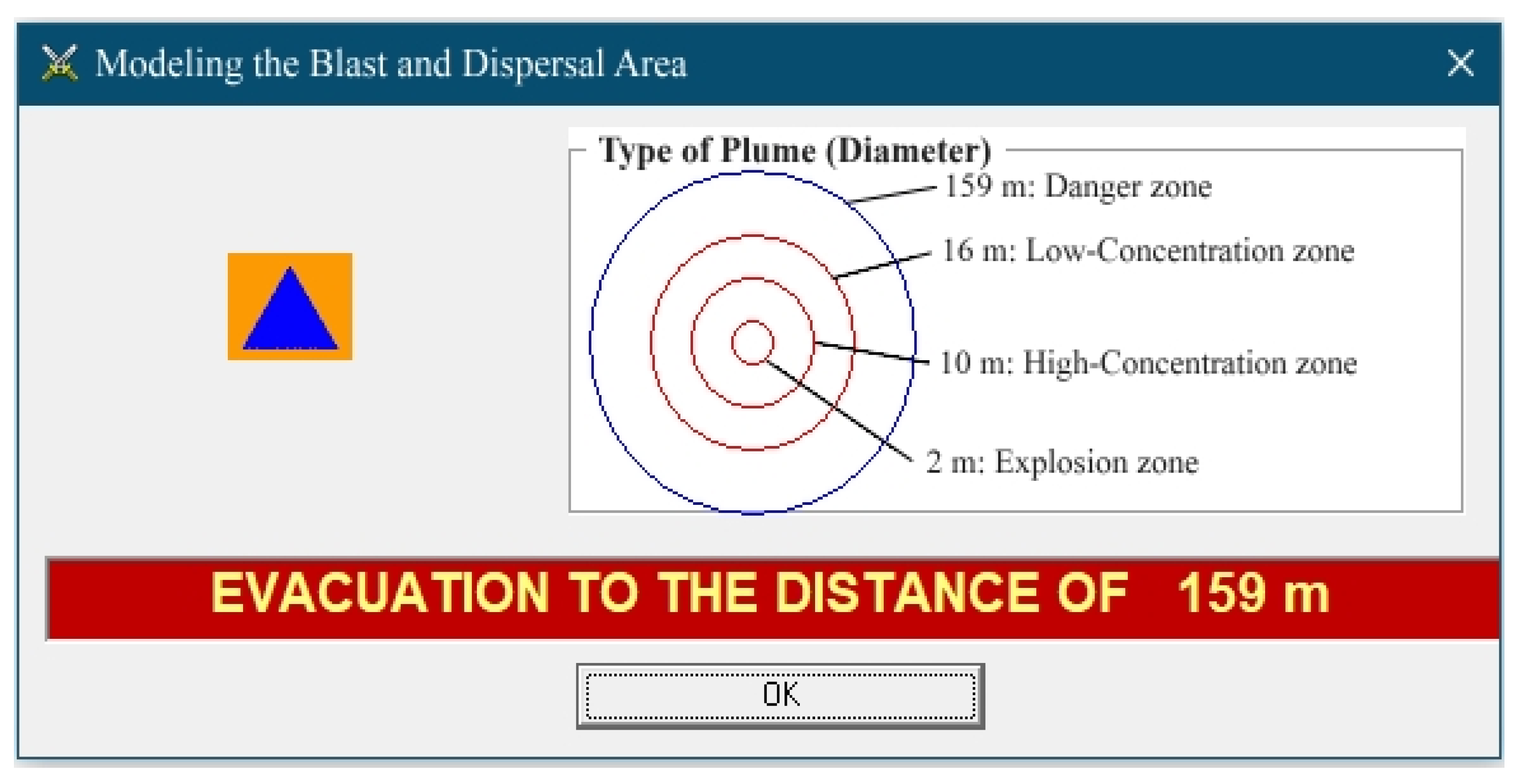
- Physicochemical properties of the agent:
- ○
- Volatility and reactivity;
- ○
- Capillarity (positive/negative);
- ○
- Boiling point.
- Projectile characteristics:
- ○
- Internal volume and fill capacity;
- ○
- Parameters of the release opening (size, position).
- Meteorological conditions:
- ○
- Air temperature;
- ○
- Vertical air movement;
- ○
- Wind direction and speed;
- ○
- Air humidity.
- Environmental factors:
- ○
- Terrain ruggedness;
- ○
- Vegetation cover;
- ○
- Surface type.
- Fire characteristics:
- ○
- Type (surface, crown, ground fire);
- ○
- Intensity (low/medium/high);
- ○
- Spread rate;
- ○
- Temperature profile of the fire core;
- ○
- Flame height and smoke density.
3. Results
4. Discussion and Conclusions
Author Contributions
Funding
Institutional Review Board Statement
Informed Consent Statement
Data Availability Statement
Acknowledgments
Conflicts of Interest
References
- Oulehlova, A.; Karaskova, L.; Kincl, P. Development of Drought Risk in the Selected Territory. In Proceedings of the 30th European Safety and Reliability Conference and 15th Probabilistic Safety Assessment and Management Conference, Venice, Italy, 1–5 November 2020; Research Publishing Services: Singapore, 2020; pp. 3118–3125. [Google Scholar]
- Oulehlova, A.; Kudlak, A.; Urban, R.; Hoke, E. Competitiveness of the Regions in the Czech Republic from the Perspective of Disaster Risk Financing. JOC 2021, 13, 115–131. [Google Scholar] [CrossRef]
- Castellet-Viciano, L.; Hernández-Chover, V.; Hernández-Sancho, F. The Economic And Environmental Impact Of Fire Preventive Strategies In The Mediterranean Region. J. Environ. Manag. 2024, 371. [Google Scholar] [CrossRef] [PubMed]
- Global Wildfire Information System (GWIS) 2025. Joint Research Centre (JRC), Ispra, Italy. Available online: https://gwis.jrc.ec.europa.eu (accessed on 11 June 2025).
- Yilgan, F.; Miháliková, M.; Kara, R.S.; Ustuner, M. Analysis of the Forest Fire in the ‘Bohemian Switzerland’ National Park Using Landsat-8 and Sentinel-5P in Google Earth Engine. Nat. Hazards 2025, 121, 6133–6154. [Google Scholar] [CrossRef]
- Casey, J.A.; Gu, Y.M.; Schwarz, L.; Frankland, T.B.; Wilner, L.B.; McBrien, H.; Flores, N.M.; Dey, A.K.; Lee, G.S.; Chen, C.; et al. The 2025 Los Angeles Wildfires and Outpatient Acute Healthcare Utilization. medRxiv 2025, arXiv:2025.03.13.25323617. [Google Scholar]
- Pazos, R.; Scarr, S.; Gopalakrishnan, R. How South Korea’s Largest and Deadliest Wildfire Spread. Reuters, 9 April 2025. [Google Scholar]
- Švehlík, M.; Sedláček, M.; Hasilová, K.; Drábek, J.; Šlouf, V. Applications in Engineer and Artillery Support: Mathematical Modeling of Symphatetic Detonation. Chall. Natl. Def. Contemp. Geopolit. Situat. 2024, 1, 634–640. [Google Scholar] [CrossRef]
- Možný, M.; Vlach, V.; Musilová, A.; Hájková, L. Severe Fire Risk Assessment In The Czech Republic. Meteorol. Zprávy 2025, 77, 186–191. [Google Scholar] [CrossRef]
- Hujer, V.; Slouf, V.; Farlik, J. Utility as a Key Criterion of a Decision-Making on Structure of the Ground Based Air Defence. In Modelling and Simulation for Autonomous Systems; Mazal, J., Fagiolini, A., Vasik, P., Turi, M., Bruzzone, A., Pickl, S., Neumann, V., Stodola, P., Eds.; Lecture Notes in Computer Science; Springer International Publishing: Cham, Switzerland, 2022; Volume 13207, pp. 249–260. ISBN 978-3-030-98259-1. [Google Scholar]
- Rehak, D.; Splichalova, A.; Janeckova, H.; Oulehlova, A.; Hromada, M.; Kontogeorgos, M.; Ristvej, J. Critical Entities Resilience Assessment (CERA) to Small-Scale Disasters. Int. J. Disaster Risk Reduct. 2024, 111, 104748. [Google Scholar] [CrossRef]
- Kincl, P.; Oulehlová, A. Assessment Criteria for Municipality Territory Resilience to Anthropogenic Threats. In Trends and Future Directions in Security and Emergency Management; Tušer, I., Hošková-Mayerová, Š., Eds.; Lecture Notes in Networks and Systems; Springer International Publishing: Cham, Switzerland, 2022; Volume 257, pp. 209–224. ISBN 978-3-030-88906-7. [Google Scholar]
- Weidinger, J. What Is Known and What Remains Unexplored: A Review of the Firefighter Information Technologies Literature. Int. J. Disaster Risk Reduct. 2022, 78, 103115. [Google Scholar] [CrossRef]
- Tornevi, A.; Andersson, C.; Carvalho, A.C.; Langner, J.; Stenfors, N.; Forsberg, B. Respiratory Health Effects of Wildfire Smoke during Summer of 2018 in the Jämtland Härjedalen Region, Sweden. Int. J. Environ. Res. Public Health 2021, 18, 6987. [Google Scholar] [CrossRef]
- Palasiewicz, T.; Rolenec, O.; Kroupa, L.; Maňas, P.; Coufal, D. Blast-Induced Deformations of the Building Entrance Part Caused by Improvised Shaped Charges. In Modelling and Simulation for Autonomous Systems; Lecture Notes in Computer Science; Springer International Publishing: Cham, Switzerland, 2023; Volume 13866, pp. 109–130. ISBN 978-3-031-31267-0. [Google Scholar]
- Sokol, A.; Sokol, I.G. II International Scientific and Theoretical Conference «FORMATION OF INNOVATIVE POTENTIAL OF WORLD SCIENCE»; European Scientific Platform, Ed.; Primedia eLaunch LLC: Dallas, TX, USA, 2021; ISBN 978-1-68564-147-4. [Google Scholar]
- Majek, V.; Slouf, V. Operations with Fuzzy Numbers in the Task Divided Targets. In Proceedings of the International Conference on Military Technologies (ICMT), Brno, Czech Republic, 19–21 May 2015; IEEE: Brno, Czech Republic, 2015; pp. 1–5. [Google Scholar]
- Jenkins, T.F.; Hewitt, A.D.; Walsh, M.E.; Ranney, T.A.; Ramsey, C.A.; Grant, C.L.; Bjella, K.L. Representative Sampling for Energetic Compounds at Military Training Ranges. Environ. Forensics 2005, 6, 45–55. [Google Scholar] [CrossRef]
- Barker, A.J.; Clausen, J.L.; Douglas, T.A.; Bednar, A.J.; Griggs, C.S.; Martin, W.A. Environmental Impact of Metals Resulting from Military Training Activities: A Review. Chemosphere 2021, 265, 129110. [Google Scholar] [CrossRef]
- Hewitt, A.D.; Jenkins, T.F.; Walsh, M.E.; Walsh, M.R.; Bigl, S.R.; Ramsey, C.A. Protocols for Collection of Surface Soil Samples at Military Training and Testing Ranges for the Characterization of Energetic Munitions Constituents; U.S. Army Engineer Research and Development Center: Vicksburg, MS, USA, 2007; Volume 7. [Google Scholar]
- Ivan, J.; Šustr, M.; Gregor, J.; Potužák, L.; Varecha, J. Advancing Soil Sampling Techniques for Environmental Assessment of Artillery Impact Zones. J. Ecol. Eng. 2025, 26, 1–14. [Google Scholar] [CrossRef] [PubMed]
- Šustr, M.; Ivan, J.; Blaha, M.; Potužák, L. A Manual Method of Artillery Fires Correction Calculation. Mil. Oper. Res. 2022, 27, 77–94. [Google Scholar]
- Ivan, J.; Silinger, K.; Potuzak, L. Target Acquisition Systems—Suitability Assessment Based on Joint Fires Observer Mission Criteria Determination. In Proceedings of the 15th International Conference on Informatics in Control, Automation and Robotics, Porto, Portugal, 29–31 July 2018; SCITEPRESS—Science and Technology Publications: Porto, Portugal, 2018; pp. 407–414. [Google Scholar]
- Drábek, J.; Potužák, L.; Havlík, T.; Vitoul, V.; Novák, J. Practical Evaluation of Instruments for Determining the Exact Position During Artillery Operations of the Czech Artillery. Chall. Natl. Def. Contemp. Geopolit. Situat. 2024, 1, 45–50. [Google Scholar] [CrossRef]
- Blaha, M.; Potužák, L.; Šustr, M.; Ivan, J.; Havlík, T. Simplification Options for More Efficient Using of Angular and Linear Measuring Rules for Fire Control. Int. J. Educ. Inf. Technol. 2021, 15, 28–34. [Google Scholar] [CrossRef]
- Sedláček, M.; Dohnal, F.; Ivan, J.; Šustr, M. Possible Approaches to Assessing Terrain Mobility after the Effects of Artillery Munition. Cogent Soc. Sci. 2024, 10, 2368096. [Google Scholar] [CrossRef]
- Švehlík, M.; Šustr, M.; Potužák, L.; Varecha, J.; Drábek, J. Creating of Minefield Breaches with Artillery. In Proceedings of the 20th International Conference on Informatics in Control, Automation and Robotics, Rome, Italy, 13–15 November 2023; SCITEPRESS—Science and Technology Publications: Rome, Italy, 2023; pp. 266–272. [Google Scholar]
- Struminska, A.; Filippone, A. Flight Performance Analysis Of Aerial Fire Fighting. Aeronaut. J. 2024, 128, 1895–1923. [Google Scholar] [CrossRef]
- Drozd, J.; Rak, L.; Zahradníček, P.; Stodola, P.; Hodický, J. Effectiveness Evaluation of Aerial Reconnaissance in Battalion Force Protection Operation Using the Constructive Simulation. J. Def. Model. Simul. 2023, 20, 181–196. [Google Scholar] [CrossRef]
- Aronsson, S.; Artman, H.; Brynielsson, J.; Lindquist, S.; Ramberg, R. Design Of Simulator Training: A Comparative Study Of Swedish Dynamic Decision-Making Training Facilities. Cogn. Technol. Work. 2021, 23, 117–130. [Google Scholar] [CrossRef]
- Gavendová, H.; Barta, J. New Horizons in Education and Educational Technology: Proceedings of the 6th WSEAS International Conference on Education and Educational Technology (EDU ’07): Venice, Italy, 21–23 November 2007; Revetria, R., World Scientific and Engineering Academy and Society, Eds.; Electrical and computer engineering series; WSEAS Press: Athens, Greece, 2007; ISBN 978-960-6766-16-9. [Google Scholar]
- Erickson, W.T.; Golshany, S.; Songstad, A.S.; Blom, W.A.; Artis, A.J.; Holtorf, R.C.; Daughtry, N. Fire-Retarding Artillery Shell. U.S. Patent US20160216091A1, 28 July 2016. assigned to The Boeing Company, Illinois, USA. Available online: https://patents.google.com/patent/US20160216091A1/en (accessed on 11 June 2025).
- Ivan, J.; Potužák, L.; Šotnar, J. Artillery Survey for Autonomous Weapon Systems and Basic Requirements on Survey Units. Vojen. Rozhl. Czech Mil. Rev. 2019, 28, 63–77. [Google Scholar] [CrossRef]
- Su, C.; Hu, Y.; Ma, Y.; Yang, J. Simulation Study and Proper Orthogonal Decomposition Analysis of Buoyant Flame Dynamics and Heat Transfer of Wind-Aided Fires Spreading on Sloped Terrain. Fire 2025, 8, 139. [Google Scholar] [CrossRef]
- Bot, K.; Borges, J.G. A Systematic Review of Applications of Machine Learning Techniques for Wildfire Management Decision Support. Inventions 2022, 7, 15. [Google Scholar] [CrossRef]
- Foltin, P.; Vlkovský, M.; Mazal, J.; Husák, J.; Brunclík, M. Discrete Event Simulation in Future Military Logistics Applications and Aspects. In Modelling and Simulation for Autonomous Systems; Mazal, J., Ed.; Lecture Notes in Computer Science; Springer International Publishing: Cham, Switzerland, 2018; Volume 10756, pp. 410–421. ISBN 978-3-319-76071-1. [Google Scholar]
- Serrano, A.; Kalenatic, D.; López, C.; Montoya-Torres, J.R. Evolution of Military Logistics. Logistics 2023, 7, 22. [Google Scholar] [CrossRef]
- Wang, H.; Zhang, K.; Qin, Z.; Gao, W.; Wang, Z. Refining Ecological Techniques for Forest Fire Prevention and Evaluating Their Diverse Benefits. Fire 2024, 7, 129. [Google Scholar] [CrossRef]

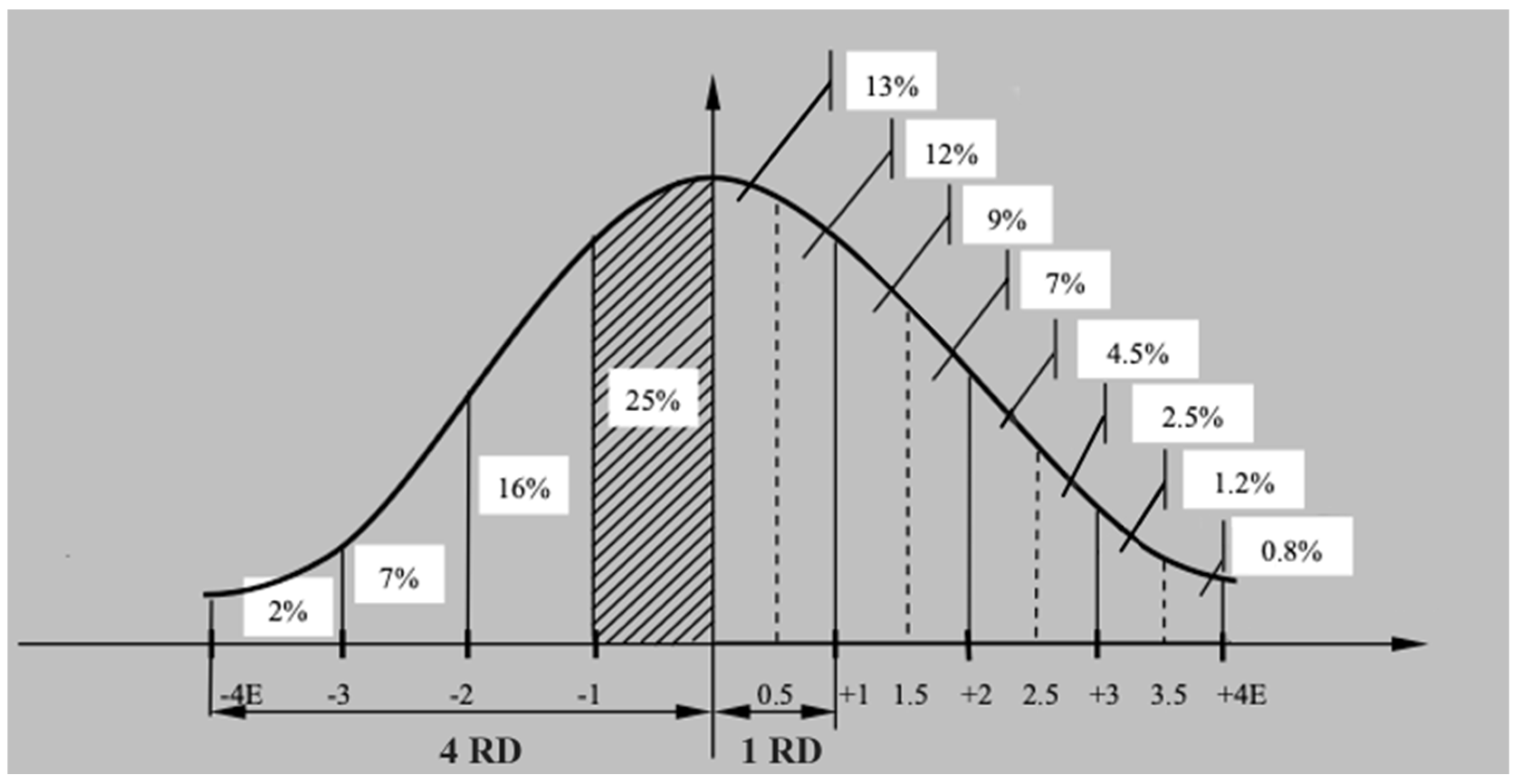

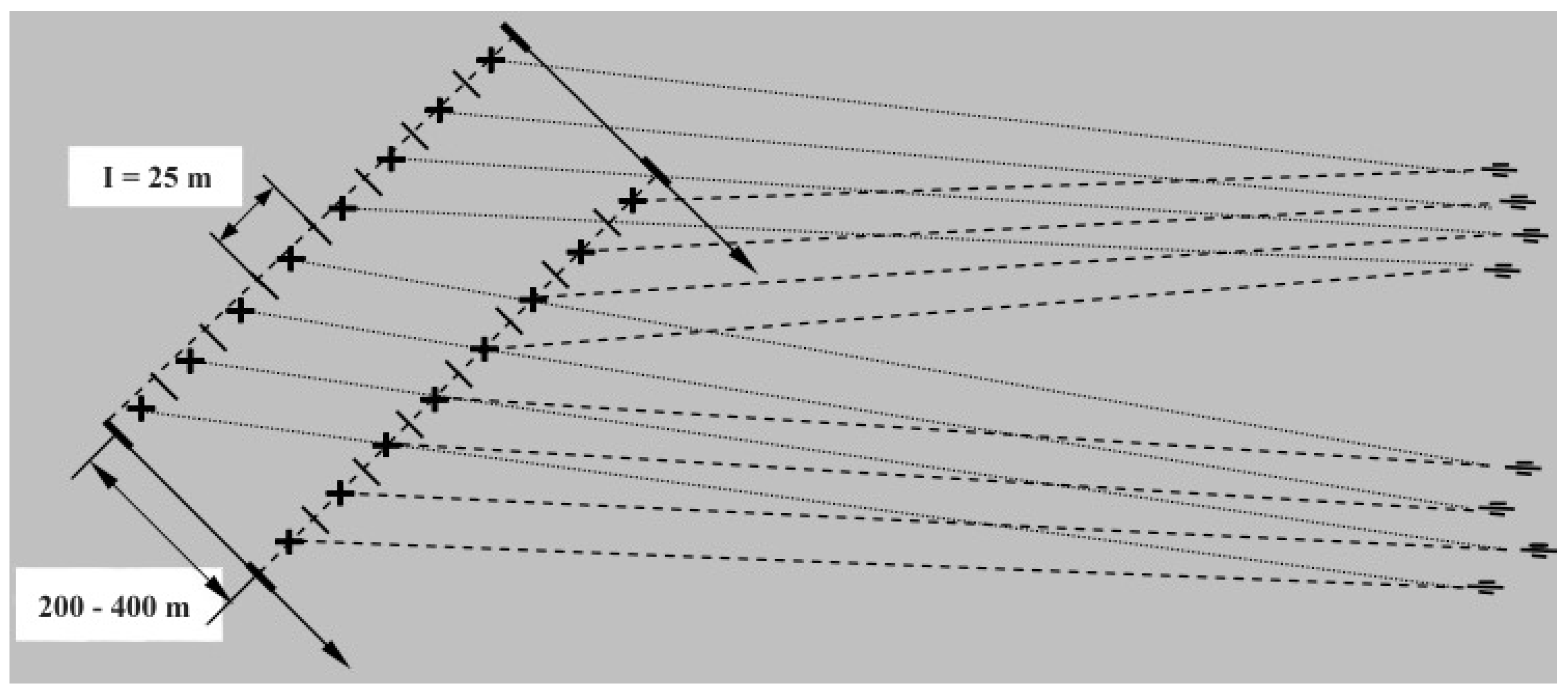
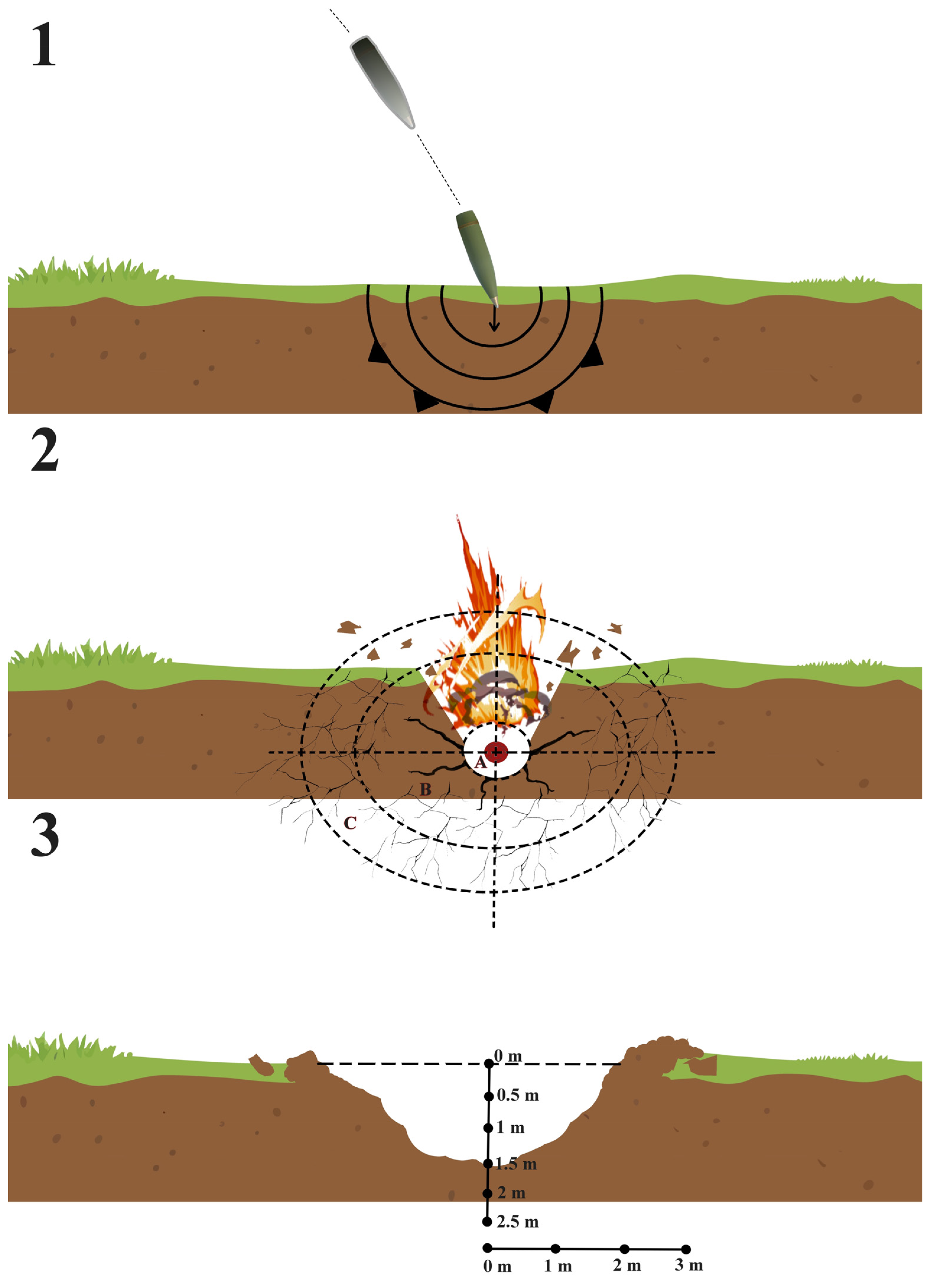
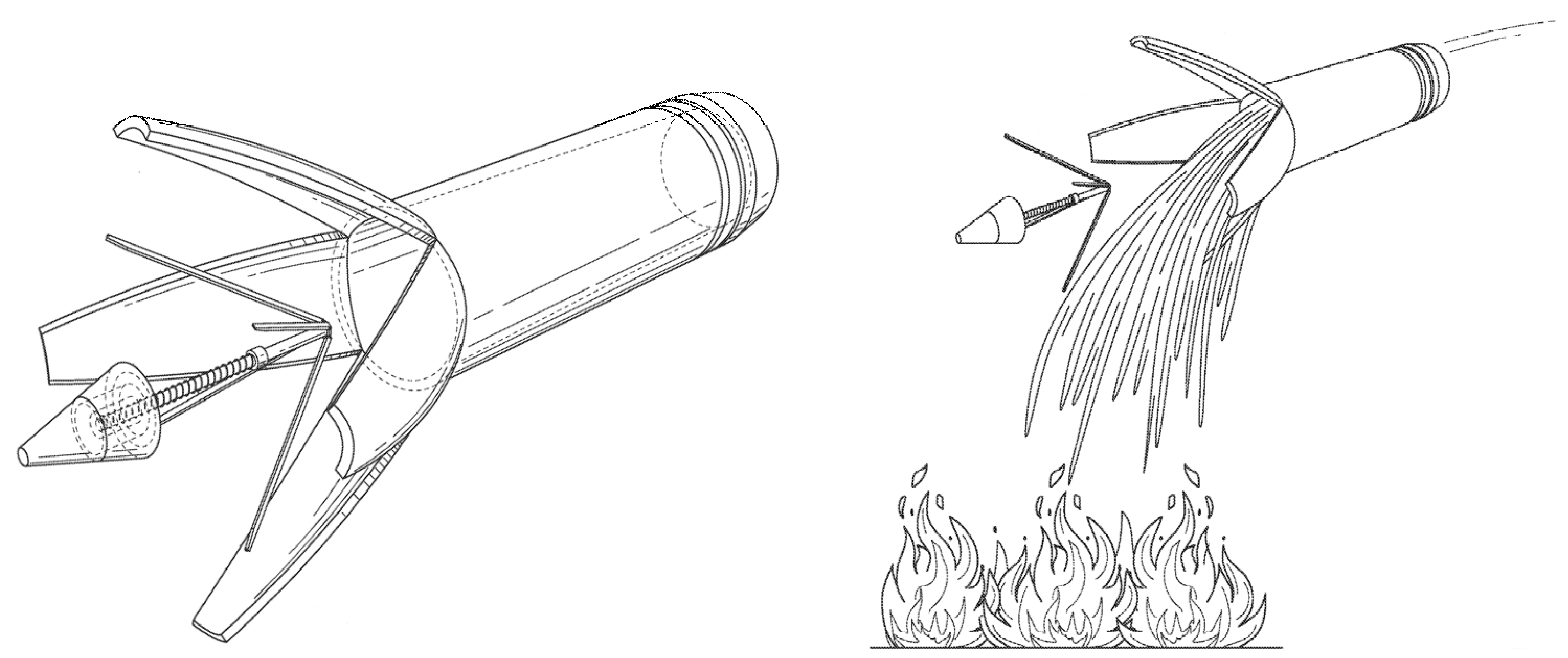

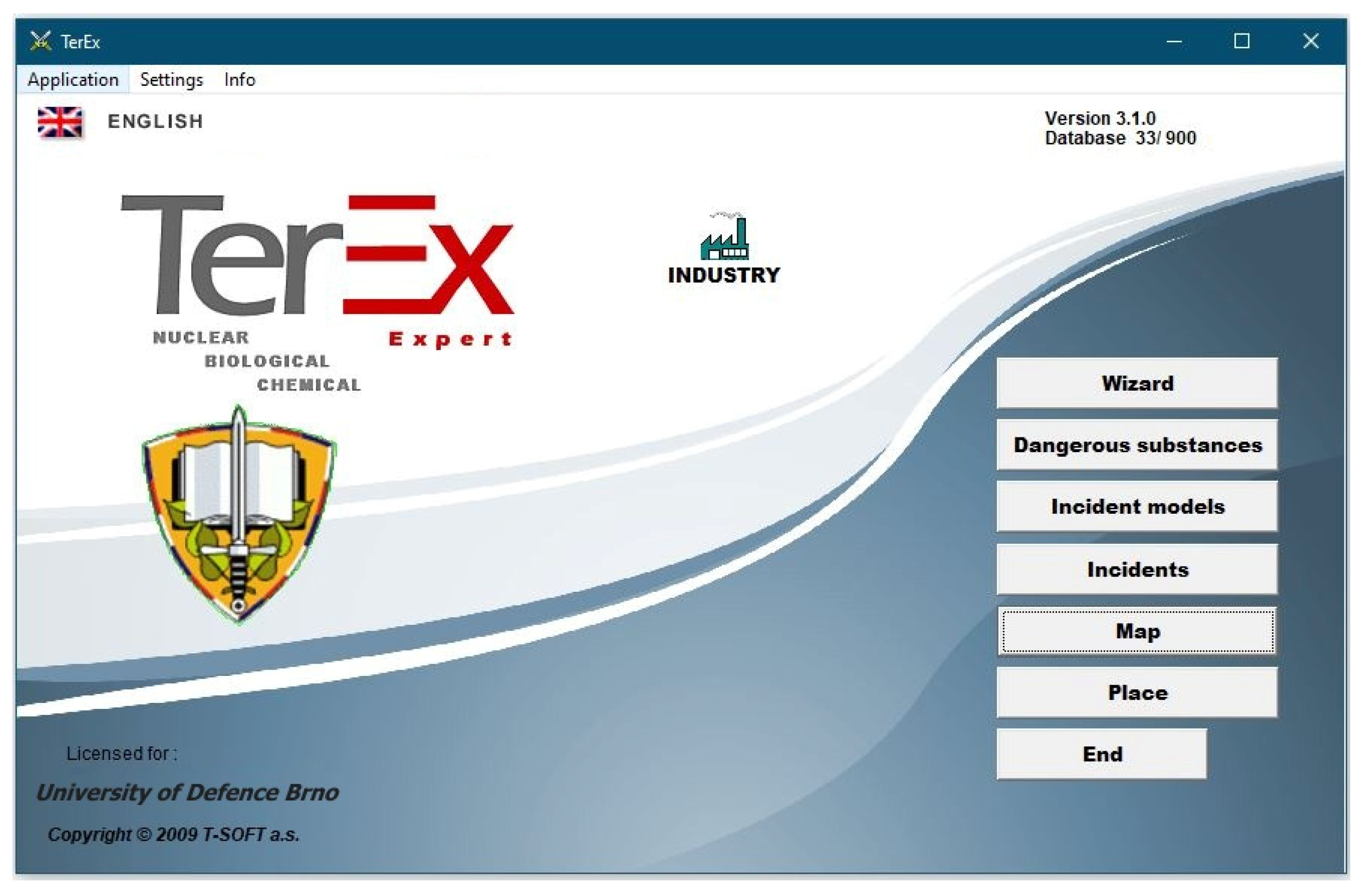
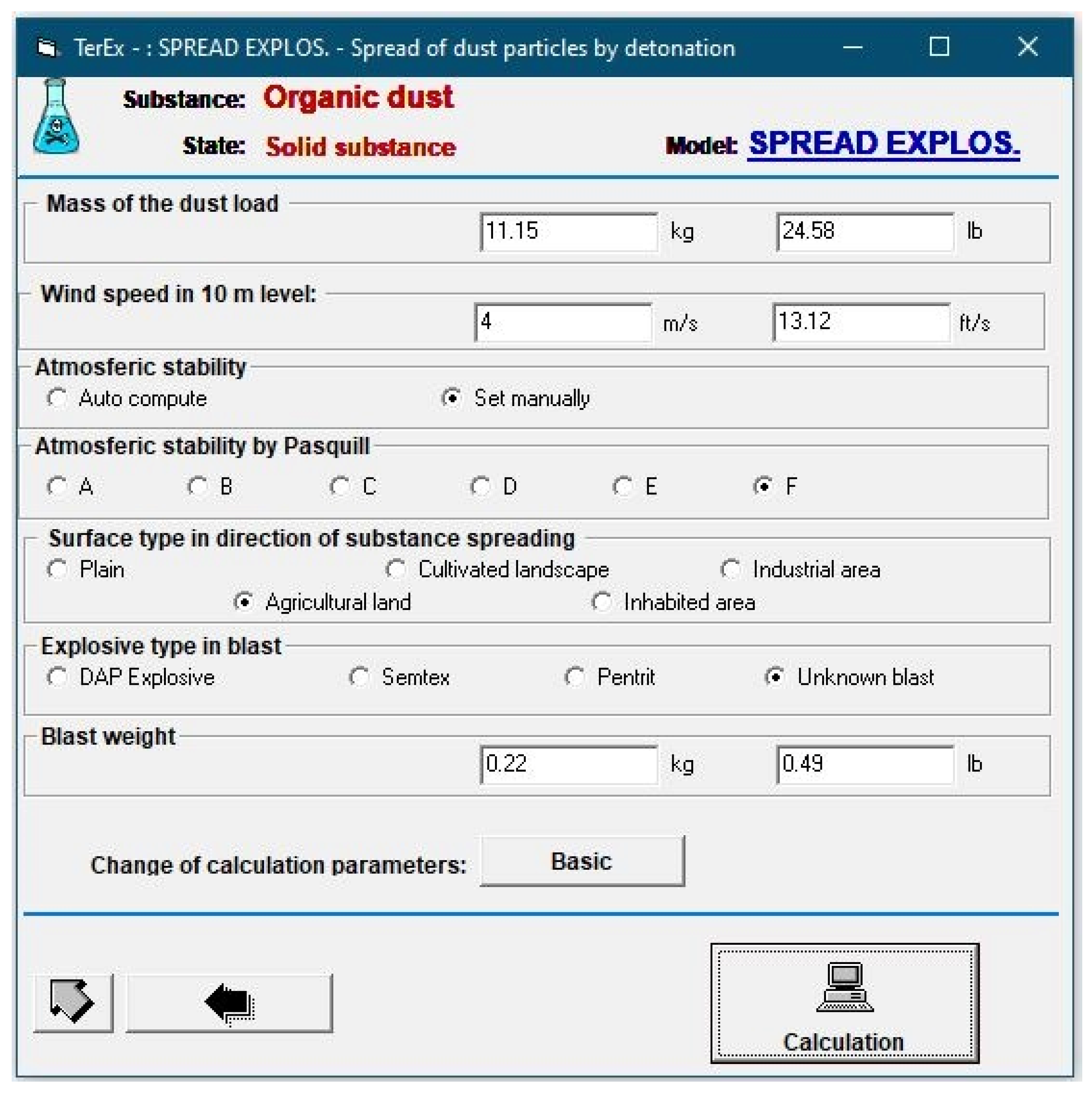
| 2.00% | 7.00% | 16.00% | 25.00% | 25.00% | 16.00% | 7.00% | 2.00% | |
| 2.00% | 0.04 | 0.14 | 0.32 | 0.50 | 0.50 | 0.32 | 0.14 | 0.04 |
| 7.00% | 0.14 | 0.49 | 1.12 | 1.75 | 1.75 | 1.12 | 0.49 | 0.14 |
| 16.00% | 0.32 | 1.12 | 2.56 | 4.00 | 4.00 | 2.56 | 1.12 | 0.32 |
| 25.00% | 0.50 | 1.75 | 4.00 | 6.25 | 6.25 | 4.00 | 1.75 | 0.50 |
| 25.00% | 0.50 | 1.75 | 4.00 | 6.25 | 6.25 | 4.00 | 1.75 | 0.50 |
| 16.00% | 0.32 | 1.12 | 2.56 | 4.00 | 4.00 | 2.56 | 1.12 | 0.32 |
| 7.00% | 0.14 | 0.49 | 1.12 | 1.75 | 1.75 | 1.12 | 0.49 | 0.14 |
| 2.00% | 0.04 | 0.14 | 0.32 | 0.50 | 0.50 | 0.32 | 0.14 | 0.04 |
| Number of Guns | Sector Dimensions [m] | ||
|---|---|---|---|
| Width of Sector | Depth of Sector | ||
| Platoon (4 guns) | 200 | 150 | |
| Battery (8 guns) | 400 | 150 | |
| Battalion | Two batteries (16 guns) | 800 | 150 |
| Three batteries (24 guns) | 1200 | 150 | |
Disclaimer/Publisher’s Note: The statements, opinions and data contained in all publications are solely those of the individual author(s) and contributor(s) and not of MDPI and/or the editor(s). MDPI and/or the editor(s) disclaim responsibility for any injury to people or property resulting from any ideas, methods, instructions or products referred to in the content. |
© 2025 by the authors. Licensee MDPI, Basel, Switzerland. This article is an open access article distributed under the terms and conditions of the Creative Commons Attribution (CC BY) license (https://creativecommons.org/licenses/by/4.0/).
Share and Cite
Korec, D.; Blaha, M.; Barta, J.; Varecha, J. Innovative Approaches to the Use of Artillery in Wildfire Suppression. Fire 2025, 8, 232. https://doi.org/10.3390/fire8060232
Korec D, Blaha M, Barta J, Varecha J. Innovative Approaches to the Use of Artillery in Wildfire Suppression. Fire. 2025; 8(6):232. https://doi.org/10.3390/fire8060232
Chicago/Turabian StyleKorec, Daniel, Martin Blaha, Jiří Barta, and Jaroslav Varecha. 2025. "Innovative Approaches to the Use of Artillery in Wildfire Suppression" Fire 8, no. 6: 232. https://doi.org/10.3390/fire8060232
APA StyleKorec, D., Blaha, M., Barta, J., & Varecha, J. (2025). Innovative Approaches to the Use of Artillery in Wildfire Suppression. Fire, 8(6), 232. https://doi.org/10.3390/fire8060232







